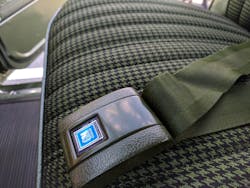For decades, the Federal Motor Carrier Safety Administration and state enforcement agencies have been mandating, encouraging, cajoling and enforcing seat belt laws to improve usage among drivers of commercial vehicles.
The good news: it appears the majority of drivers have gotten the message. In 2007, seat belt usage among commercial vehicle drivers stood at 65%. In every survey conducted since then (2008, 2009, 2010, 2013 and 2016), the numbers continue to improve. According to the Seat Belt Usage by Commercial Motor Vehicle Drivers Survey conducted by the U.S. Department of Transportation, usage increased from 83% in 2013 to 86% in 2016.
Here’s a more detailed look at some of the survey findings:
- Failing to use a seatbelt remains one of the most common driver violations, behind log book violations and speeding.
- By region, the South, Midwest, and West all average 87% usage. The Northeast stands at 71%.
- Male drivers were observed using their seatbelts at a rate of 86% while female drivers were at 84%.
- There is evidence that states with primary seat belt laws see greater usage than states with secondary laws. (Primary enforcement laws allow drivers to be stopped and ticketed simply for not wearing a seat belt; while secondary laws require that the driver be stopped for another violation before a ticket can be issued.)
- There also was greater usage on expressways than surface streets, and in heavy traffic as opposed to lighter traffic.
What has caused this increased emphasis on seatbelt usage by commercial vehicle drivers? Could aggressive enforcement be driving compliance with seatbelt laws?
I suggest that while some of the change is a result of enforcement, the majority of the praise must go to the carriers and drivers themselves. The 2013 Survey mentioned that seatbelt usage was higher for fleet drivers (86%) than independent drivers (75%). This suggests fleets have integrated a number of actions to make their drivers to buckle up.
For instance, many company-written driver policies contain seat belt statements and supervisors strongly emphasize seatbelt usage. At some companies, progressive disciplinary policies for non-compliance don’t go easy on violators. Additionally, some companies offer incentives for seatbelt use and safe driving habits.
Sometimes just improving the visibility of the issue leads to positive changes. Using brightly colored seatbelts has made identification of violators easier for both law enforcement and company safety department personnel. Visible reminders posted in the cab, on mirrors, and on paperwork all serve to reinforce the use of seatbelts.
The Governors Highway Safety Association states that in 2016 seat belt usage among all road users was at 90%. While CMV drivers lag behind, they are doing a good job of improving that percentage and protecting themselves by buckling up.
While 100% seatbelt usage is definitely the goal, this steady increase is something of which everyone can be proud. Continued perseverance will not only increase seatbelt usage, but more importantly, it will serve to save lives across the nation.
About the Author
Steve Vaughn
Senior Vice President of Field Operations
Steve Vaughn is senior vice president of field operations at PrePass Safety Alliance, the provider of PrePass weigh station bypass and electronic toll-payment and management services. Vaughn served nearly three decades with the California Highway Patrol and is a past president of the Commercial Vehicle Safety Alliance.
